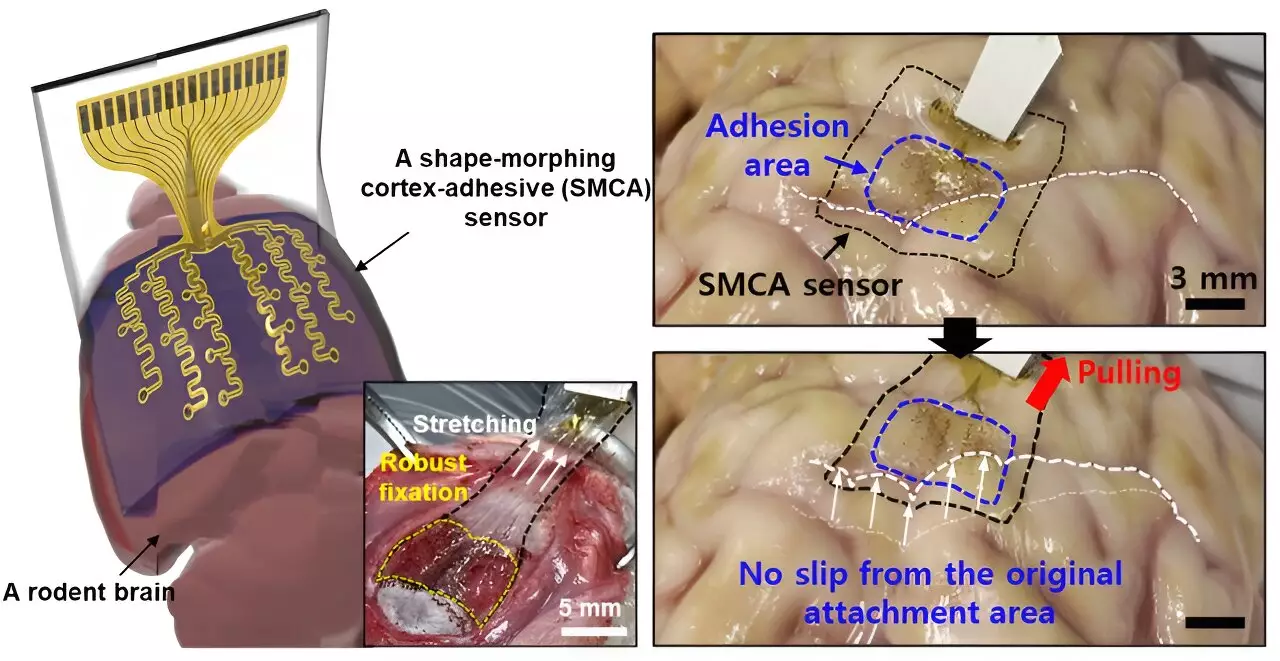Transcranial focused ultrasound (tFUS) represents a groundbreaking approach in the field of neuroscience, rooted in the application of high-frequency sound waves to non-invasively target and stimulate specific regions of the brain. This innovative technique holds significant promise, particularly for treating severe neurological conditions such as drug-resistant epilepsy and various movement disorders characterized by tremors. The recent collaborative research effort by scientists from Sungkyunkwan University (SKKU), the Institute for Basic Science (IBS), and the Korea Institute of Science and Technology focuses on an inventive sensor designed to enhance the efficacy of this treatment modality.
A fundamental issue with existing brain sensors has been their inability to accurately measure neuronal signals. Donghee Son, the lead author of a study published in *Nature Electronics*, highlighted the difficulties previous brain sensors faced due to inadequate conformance to the brain’s intricate surface folds. Such limitations impeded precise diagnoses of brain lesions and related conditions. Prior advancements, including those made by Professors John A. Rogers and Dae-Hyeong Kim, made strides towards better adherence to the brain surface but still struggled with the complex curvature found in certain brain regions.
These earlier iterations could collect valuable data but often fell short in terms of stability and longevity, meaning they occasionally detached from the neural tissue, especially when confronted with the subtle motions of the brain and cerebrospinal fluid dynamics. This detachment directly influenced the sensors’ overall effectiveness in clinical situations, as consistent and accurate measurements became an unattainable goal.
Responding to these challenges, Son and his colleagues developed a new sensor that dramatically improves the interaction between the device and brain tissue. Known as the electrocorticography (ECoG) sensor, this cutting-edge technology boasts the ability to embrace the intricacies of brain anatomy while maintaining a secure attachment. As explained by Son, the ECoG sensor’s tight adhesion is crucial for minimizing noise that can distort signal readings, particularly during low-intensity focused ultrasound (LIFU) treatments, known to help mitigate epileptic activity.
The necessity of real-time brain wave monitoring is integral to personalizing treatments for epilepsy and other neurological disorders. Existing technologies often generated excessive noise from induced vibrations during stimulation, thus obstructing the accurate assessment required for tailored therapy. The innovative ECoG sensor addresses these concerns, laying the framework for improved personalization in treatment strategies through its noise-reducing capabilities.
The design of the ECoG sensor consists of three distinct yet synergistic layers that facilitate its functionality. First, the hydrogel-based layer initiates strong adhesion through both chemical and physical bonding with brain tissue. Second, a self-healing polymer layer allows the sensor to adapt its shape dynamically, conforming to the varying topographies of the brain. Finally, a thin and stretchable layer comprising gold electrodes ensures optimal signal transmission between the sensor and the neural pathways.
Following application, the hydrogel layer undergoes a gelation phase, effectively securing itself to the brain’s surface. As the self-healing polymer adjusts to the curvature of the anatomy, it amplifies the contact area, thereby ensuring reliability in data collection over an extended duration. This unique configuration not only fosters the sensor’s effectiveness but also alleviates the noise interference that has plagued prior technologies.
The implications of the ECoG sensor extend beyond the treatment of epilepsy. Given its adaptability and precision, the researchers anticipate its application could broaden to include diagnostics and treatment strategies for a variety of neurological disorders. Son’s team envisions a completely revamped approach to brain signal analysis through a more extensive electrode array, significantly enhancing the resolution of captured neural data, paving the way for refined treatment methodologies.
Initial trials conducted on awake rodents yielded promising results, showcasing the sensor’s ability to accurately monitor brain waves and exercise control over seizure activity. With the prospect of clinical trials on the horizon, the potential for this sensor to facilitate significant advancements in neurological treatment is immense. The upcoming phase includes expanding electrode count and refining design parameters to perfect this innovative neurotechnology.
The developments in transcranial focused ultrasound technology and the emergence of the ECoG sensor herald a new era for treating neurological conditions. By addressing previous limitations in sensor technology, researchers may unlock new possibilities for personalized treatment plans that dramatically improve patient outcomes. Observing the outcomes of potential clinical applications will be crucial in reaffirming the value that this technology brings to the medical community and in reshaping approaches to neurotherapeutics in the years to come.


Leave a Reply